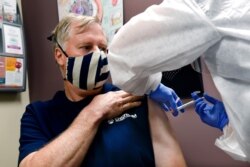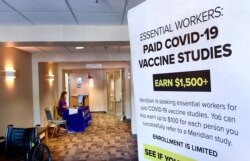Two COVID-19 vaccines that could arrive as soon as November use a promising new technique that experts say speeds up the development process.
The new vaccines will be the first test to see if vaccines based on genetic code, rather than the germ itself, can be safe and effective. U.S.-based biotech company Moderna is developing one. The other is the product of a collaboration between German drugmaker BioNTech and U.S.-headquartered Pfizer.
All previous vaccines have triggered the immune system with dead or weakened versions of a germ or parts of it. The active ingredient in each of the new vaccines is a piece of genetic code called mRNA. It instructs the body to produce one small piece of the virus. It does not cause illness, but it primes the immune system to fight off the real virus.
Producing enough vaccine for hundreds of millions of doses usually requires large, specialized biological manufacturing systems to grow the germ or its parts. The mRNA vaccines are quicker to develop in part because they do not rely on these complex systems. Plus, mRNA is a string of chemical building blocks that can be quickly modified to produce a new vaccine to combat a different germ.
These are the first vaccines based on genetic code to be developed for human patients. Several veterinary vaccines using this technique are on the market, including immunizations against West Nile virus in horses, melanoma in dogs and a viral disease in salmon.
Tests under way
In early safety tests, a few dozen healthy people received either a vaccine or a placebo for comparison. Both vaccines produced side effects such as headaches, fever, chills, fatigue, or sore muscles in most patients. None were serious enough to stop the testing.
Moderna and Pfizer/BioNTech have advanced their vaccines to the final round of testing, which involves about 30,000 patients each. These trials are designed to determine how effective they are, as well as look for less common side effects.
Final results are not expected until the end of the year, but Food and Drug Administration Commissioner Stephen Hahn told the Financial Times that the agency could allow the vaccines to be used sooner if early results are good enough.
Guidance from the U.S. Centers for Disease Control and Prevention (CDC) says public health agencies should be ready to distribute a vaccine by November 1, shortly before the presidential election. Many public health experts have expressed concerns that President Donald Trump will pressure the FDA to approve a vaccine to improve his election prospects regardless of how the testing is progressing.
Hahn dismissed fears that the decision could come under pressure from the White House.
"This is going to be a science, medicine, data decision," he said. "This is not going to be a political decision."
'Very unlikely'
Experts doubt enough data would be available to make a good decision by November, however.
"I would be surprised," said Walter Orenstein, associate director of the Emory Vaccine Center in Atlanta, Georgia. "I can't say it's impossible, but I think it would be very unlikely."
It takes time to enlist the tens of thousands of people needed to do a proper clinical trial, said Paul Offit, director of the Vaccine Education Center at the Children's Hospital of Philadelphia. The vaccines require two doses, and "not everybody has been recruited to get dose one yet. You have to wait a month to get dose two. So we're already into October. Then you have to wait two weeks until you have full immunity."
And then, he added, at least 150 or so people who received the placebo have to get sick in order to have enough cases to compare to those who received the vaccine.
Though experts are skeptical that results will be conclusive enough by November, they say it's not a bad idea to start planning now, because it's going to be an incredibly complicated exercise.
The federal government has committed billions of dollars to buy hundreds of millions of doses of the vaccines. But that's just the start.
"It's not just buying vaccine. We need to ensure we have the resources to deliver the vaccines to the people who need it," Orenstein said. That's no easy task for a nation of 330 million people.
Twice the effort
Plus, since both vaccines require two doses, "it will take twice the effort to get people vaccinated," said Vanderbilt University infectious disease expert William Schaffner, a spokesman for the Infectious Diseases Society of America. "You have to track who's received which vaccine. You won't be able to mix and match."
Then there's the question of who gets the first doses. There won't be enough vaccine for everyone right away. Committees at the CDC and the National Academies of Sciences, Engineering, and Medicine are working on setting priorities with comments from the public.
Once that's settled, officials not only have to identify who is in the priority groups, "you have to make sure that people who aren't in those groups don't get those vaccines initially," Offit said. "That's going to be an enormous strain."
Even the basic issue of how to store the vaccine gets complicated. One of the vaccines needs to be stored at -70C. Standard freezers run about -20C. Big institutions may have the capacity, but "I'm a little concerned about the average doctor's office and clinic," Schaffner said.
All this is being put on state and local public health departments suffering from years of underfunding, the results of which have become abundantly clear under COVID-19.
Are they up to the job?
"I'm more hopeful than confident," Schaffner said.












